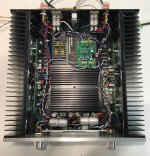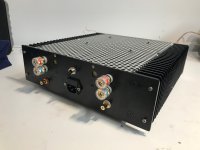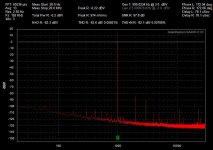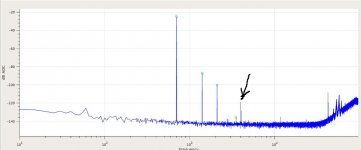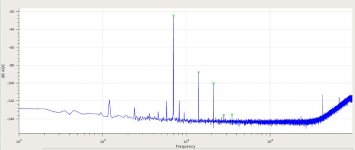I built the Juma F5 2sk2013/2sj313 with dual output switcher a while back. Worked out great! I was also a little worried about what happened if one rail failed, so added a bit of speaker protection. The speakers outputs had relays whereby both rails had to be up in order to turn on the relays. Seemed good enough for worst case failure.
In terms of using two separate supplies for +/- I suppose beat frequencies is possible. Probably less likely if you get a dual voltage output on the same unit. That’s what I had.
In the case of the din rail type power supplies, I used to use them a lot in my work (PLC programming), and they tend to be a bit buzzy. Put them on a scope though and see where the switching frequency is.
In terms of using two separate supplies for +/- I suppose beat frequencies is possible. Probably less likely if you get a dual voltage output on the same unit. That’s what I had.
In the case of the din rail type power supplies, I used to use them a lot in my work (PLC programming), and they tend to be a bit buzzy. Put them on a scope though and see where the switching frequency is.
Attachments
I recently did an experiment with a F7-like amplifier using a pair of Mean Well IRM-90-24ST power modules for one of the stereo channels. There was definitely some kind of beat frequencies visible in the output spectrum, but the level was about 100dB below 1 Watt (about 3uV rms) at a frequencies near 4kHz shown in the first image below. The spectrum was for a 1kHz input with a 4V peak output into 8 Ohms (1 Watt). The beat frequencies did not change when the fundamental frequency was changed, suggesting that the beat frequencies were between the SMPS switching frequencies and not the spectrum analyzer test frequency.Unless the two SMPS units in question have a feature that allows their switching frequencies to by synchronized to each other, there is a risk that an audio range 'beat' frequency may be present when they are connected in series.
One of the primary advantages of small brick style SMPS units is their simplicity of use and operation. The primary examples of this are the kit ACA and VFET amplifiers. Once the brick SMPS is replaced with larger chassis mount SMPS, output filtration and internal OSC synchronization, then the simplicity aspect disappears, and there may be a number of issues with which the DIY community at large has limited knowledge.
I will also add that in every case where I have substituted a carefully built linear supply for either a brick style or chassis mount SMPS, the linear supply has proven to sound superior. It is possible that a fine sounding example of a Class A compatible SMPS exists, but the jury is still out on that matter.
Channel with SMPS supplies:
View attachment 1025454
Channel with linear power supply:
View attachment 1025457
Attachments
I forget to mention that I placed RC filters between the outputs from the SMPS modules and the amplifier boards. R=0.22R C=22mF.
Ihquam,
Thank you for sharing the results of your experiment. Great job!
A couple questions: Was the linear power supply regulated? And, could you hear a difference?
Thank you for sharing the results of your experiment. Great job!
A couple questions: Was the linear power supply regulated? And, could you hear a difference?
The problem here could have been the use of two switching supplies, running at two close, but dissimilar, frequencies.I recently did an experiment with a F7-like amplifier using a pair of Mean Well IRM-90-24ST power modules for one of the stereo channels. There was definitely some kind of beat frequencies visible in the output spectrum, but the level was about 100dB below 1 Watt (about 3uV rms) at a frequencies near 4kHz shown in the first image below. The spectrum was for a 1kHz input with a 4V peak output into 8 Ohms (1 Watt). The beat frequencies did not change when the fundamental frequency was changed, suggesting that the beat frequencies were between the SMPS switching frequencies and not the spectrum analyzer test frequency.
Channel with SMPS supplies:
View attachment 1025454
Channel with linear power supply:
View attachment 1025457
I think for power amplifiers the typical approach would be to use a single LLC producing both rails at the same time.
techtool: The linear supply was not regulated, and there was no audible difference between the two channels.
5th element: I would not say that there was any problem due to the low level beat frequencies of the pair of SMPSs.
5th element: I would not say that there was any problem due to the low level beat frequencies of the pair of SMPSs.
But Patrick, as a sophisticated objectivist (and subjectivist) you would have to concede that there surely are techniques that would resolve this as an issue. Not only that, but I expect you would be able to explicate a few of them...I have a different conclusion. 🙂
You cannot avoid HF pickup completely even with an external SMPS.
Cheers,
Patrick

Yes, and I actually have a project with a portable device that cannot avoid a SMPS.
But it is still not entirely satisfactory.
One can argue that it is not audible, but it is there.
Just as that I have no doubt you will be able to come up with an ingenious Class D design.
But we have yet to see one. 🙂
Cheers,
Patrick
PS I also have been on that topic with Jan a lot, who has his famous Silent Switcher.
We both agree there are limitations.
.
But it is still not entirely satisfactory.
One can argue that it is not audible, but it is there.
Just as that I have no doubt you will be able to come up with an ingenious Class D design.
But we have yet to see one. 🙂
Cheers,
Patrick
PS I also have been on that topic with Jan a lot, who has his famous Silent Switcher.
We both agree there are limitations.
.
Last edited:
There is a difference between whether SMPS works in a certain application,
or whether it is the preferred solution.
Patrick
or whether it is the preferred solution.
Patrick
So it seems SMPS will work for most people. Lets face it, so many of our worries just don't really materialize in many setups. But I think mandatory is checking with a scope for oscillations and any large amounts of HF hash on ins- and outputs. If you have a nasty spike at 100kHz, does it matter? It may if you have other digital devices that happen to be easily affected, such as ADCs, bluetooth receivers, etc. But you'll only find out if you try.
It's kinda like swapping opamps. - You need to check for high frequency oscillations or other weird artifacts. Or do you?... if it sounds good to you then thats fine. This is a hobby after all.
As for me, I am not scared of using SMPS but will add filters on both input and output of any SMPS even if I don't hear any byproducts, mostly for EMI concerns, Also ensure the SMPS is shielded relatively tightly (faraday cage) to try and limit it's emissions. There are ways to use SMPS and then there are ways to try and optimize the use of SMPS. But bottom line, this is just a hobby.
It's kinda like swapping opamps. - You need to check for high frequency oscillations or other weird artifacts. Or do you?... if it sounds good to you then thats fine. This is a hobby after all.
As for me, I am not scared of using SMPS but will add filters on both input and output of any SMPS even if I don't hear any byproducts, mostly for EMI concerns, Also ensure the SMPS is shielded relatively tightly (faraday cage) to try and limit it's emissions. There are ways to use SMPS and then there are ways to try and optimize the use of SMPS. But bottom line, this is just a hobby.
If you have a nasty spike at 100kHz, does it matter?
Yes.
this is just a hobby
So everyone can do what they want.
But Nelson raised a point to me personally.
So I responded to him accordingly, without claiming any universal truth.
Linear supply will still remaining my personal choice for the foreseeable future.
And I only make my choices on performance, not on costs.
But it is my personal choice, to which I am entitled.
Nothing more, nothing less.
Cheers,
Patrick
How do I know what filter komponenter to use.
I mean wich is the switching frekvensy?
It might not be printed on the smtp..
I mean wich is the switching frekvensy?
It might not be printed on the smtp..
As you have done this, can you shed any light on their dynamic current capability. In other words, draw a parallel with SMPS requirements and a linear cap bank. Where in a linear, you can size the transformer on the close side as long as you have enough coulombs of storage for transients. ( and low enough impedance) Do you just size a SMPS larger? I have wondered if this is why some newer amps, class D and even what I have been told about the Benchmark, being a bit "flat". Is it the lack of so much distortion we are used to, or are the supplies a bit small?I've had absolutely outstanding success with SMPS, and am going to happily try in more amplifiers. Linear is not automatically superior in my experience.
Please try yourself and come to your own conclusions.
I agree. My preferred PSU is tube rectified, with the massive old choke...Yes.
So everyone can do what they want.
But Nelson raised a point to me personally.
So I responded to him accordingly, without claiming any universal truth.
Linear supply will still remaining my personal choice for the foreseeable future.
And I only make my choices on performance, not on costs.
But it is my personal choice, to which I am entitled.
Nothing more, nothing less.
Cheers,
Patrick
But even tho I love my tubes and their incredible inefficiencies, I must accept we are entering a greener era. More and more the technology is going to switch-mode and away from linear. Unfortunate, I believe our modern era peaked in the '90s, before all our worries and the tiny circuitry getting still tinier. At work I am dealing with 0201s... I hate that tiny crap. At home I love building point to point with my 3W Beyschlag carbon films.
So I'm like... if you dont know how to check the frequencies... Well, I guess I already said this is a hobby, but I kinda assumed a minimal effort on some aspects...How do I know what filter komponenter to use.
I mean wich is the switching frekvensy?
It might not be printed on the smtp..
Anyways, filters... find app-notes. Google. There are TONs.
As mentioned so many times... SMPS cannot be over sized. There is a thing called skip mode. Google it. Dont people read the thread or do they just ignore anything they dont understand and just keep going?As you have done this, can you shed any light on their dynamic current capability. In other words, draw a parallel with SMPS requirements and a linear cap bank. Where in a linear, you can size the transformer on the close side as long as you have enough coulombs of storage for transients. ( and low enough impedance) Do you just size a SMPS larger? I have wondered if this is why some newer amps, class D and even what I have been told about the Benchmark, being a bit "flat". Is it the lack of so much distortion we are used to, or are the supplies a bit small?
Oh well. This is why I must remind myself its just a hobby. Try anything and just enjoy...
Want to go green, then listen to in-ear plugs with your smartphone.
Or generate your electricity with solar, and listen to Class A in winter only.
The dissipation is part of the heating system. 😉
And don't change your laptop / smartphone every two years.
Use them until they no longer work (I still have fully working laptops with Win 3.1).
Most have no idea how much polution this causes.
Or worse, they don't want to know.
Patrick
Or generate your electricity with solar, and listen to Class A in winter only.
The dissipation is part of the heating system. 😉
And don't change your laptop / smartphone every two years.
Use them until they no longer work (I still have fully working laptops with Win 3.1).
Most have no idea how much polution this causes.
Or worse, they don't want to know.
Patrick
I think you missed my question. Sure, can't OVERSIZE, but at what point is it UNDERSAZED?As mentioned so many times... SMPS cannot be over sized. There is a thing called skip mode. Google it. Dont people read the thread or do they just ignore anything they dont understand and just keep going?
Oh well. This is why I must remind myself its just a hobby. Try anything and just enjoy...
But I am talking about margins. How do you size the supply to deliver the peak current for worst case transients? Is the output impedance low enough for said transients to maintain the rail regulation? That includes any filtering. Is this a possible cause for some amps to sound a bit lifeless? As in the cost cutters undersized the supply? Ripple bursts in safe mode? If my rated current per rail is, say 2 amps, does a 2 amp supply suffice? Or should it be 3, 4?
If using old supplies, do consider the electrolytic caps.
luckily or not, in my neck of woods, getting linear PSU done is still cheaper (and easier!!, which is more important) than getting comparative quality SMPS
speaking strictly of dual rail arrangement, speaking of repeatability/quantity
fact that I'm having few industrial/bespoke SMPS specimens is just weird exclusion; in fact, one of them is Godzilla like, 30Vsomething, zillion amps, made for cellphone xmitters
when and what for and will I use it ......... dunno, I'm still young ......
speaking strictly of dual rail arrangement, speaking of repeatability/quantity
fact that I'm having few industrial/bespoke SMPS specimens is just weird exclusion; in fact, one of them is Godzilla like, 30Vsomething, zillion amps, made for cellphone xmitters
when and what for and will I use it ......... dunno, I'm still young ......

- Home
- Amplifiers
- Pass Labs
- Can SMPS use for Class A?
